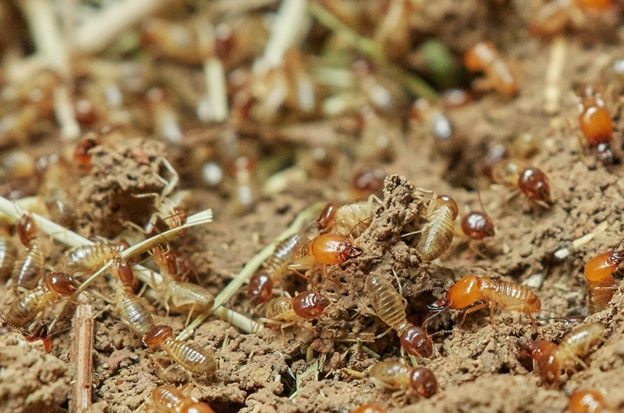
Termite Damage and Prevention
Termites, often referred to as “silent destroyers,” pose a significant threat to homes across the globe. These minuscule insects possess an extraordinary ability to inflict substantial damage on wooden structures without exhibiting overt signs of infestation. Their destructive capacity, coupled with their covert operations, renders them a formidable adversary for homeowners. Over time, termites can compromise the structural integrity of a home, leading to costly repairs, and in severe cases, even collapse.
Understanding the Enemy: Termites
To effectively combat termites, it’s imperative to comprehend their behavior and life cycle. Subterranean termites, the most prevalent type, construct colonies underground and develop mud tubes to access wood sources. These industrious insects diligently consume wood, gradually hollowing out beams, floor joists, and other wooden components of a home. Drywood termites, conversely, establish colonies within the wood itself, creating minute holes and tunnels as they feed.
A termite colony is a complex social structure comprising distinct castes, each with a specialized role. The queen is the reproductive powerhouse, laying thousands of eggs to sustain the colony’s growth. The king’s responsibility is to mate with the queen. Workers, the most numerous caste, undertake the tasks of foraging for food, building tunnels, and caring for the young. Soldiers, equipped with formidable mandibles, protect the colony from predators and intruders.
Termites exhibit remarkable communication abilities, relying on pheromones and physical contact to coordinate their activities. Pheromones, chemical signals released by termites, guide colony members to food sources, alert them to danger, and facilitate the exchange of information.
Recognizing the signs of a termite infestation is crucial for timely intervention. While termites themselves often remain concealed, their activity can leave behind telltale clues. Look for mud tubes on exterior walls or foundations, a hollow sound when tapping wood, discarded wings, and termite swarms, particularly near light sources. These indicators suggest a potential termite problem that demands immediate attention.
The Devastating Impact of Termite Damage
The extent of termite damage can be catastrophic. These relentless insects can compromise the structural integrity of a home, leading to weakened beams, sagging floors, and compromised load-bearing walls. The consequences of such damage can be catastrophic, both in terms of safety and financial burden.
Beyond the structural risks, termites can also cause significant damage to personal belongings. Furniture, books, and other wooden items are susceptible to termite attacks. The emotional and financial toll of replacing cherished possessions can be overwhelming.
The economic impact of termite damage is substantial. Repairing structural damage, replacing infested wood, and restoring a home to its original condition can be extremely costly. Additionally, the devaluation of a property due to termite infestation can significantly impact its resale value.
Homeowners insurance policies often cover termite damage, but there are typically exclusions and limitations. It’s essential to review your policy carefully to understand your coverage and any potential deductibles.
Prevention is Key: Protecting Your Home
Preventing a termite infestation is far more cost-effective than dealing with the consequences of an established colony. Regular inspections are essential for early detection. Professional pest control companies possess the expertise to conduct thorough examinations, identify potential vulnerabilities, and recommend appropriate preventive measures.
Creating an inhospitable environment for termites can also deter them from your property. Proper moisture control is crucial, as termites thrive in damp conditions. Repairing leaky pipes, improving ventilation, and addressing any water accumulation issues can help reduce the attractiveness of your home to termites. Additionally, eliminating wood-to-soil contact by raising structures and creating physical barriers can help prevent termite access.
While professional termite control is highly recommended, there are some DIY preventive measures homeowners can take. Regular inspections of wood for signs of termite activity, sealing cracks and crevices in the foundation, and using termite-resistant materials during construction or renovations can help reduce the risk of infestation. However, it’s important to recognize the limitations of DIY treatments and when to seek professional assistance.
Environmental Factors and Termite Activity
Climate plays a significant role in termite populations and activity levels. Warm, humid conditions create ideal breeding grounds for termites, while colder climates tend to have lower termite populations. If you were to search What do termites look like in Florida? you will run across Drywood Termites, which love the humid Florida climate but are much more rare than subterranean termites.
Human activities, such as deforestation and construction, can also impact termite behavior. By disrupting natural habitats and creating new wood sources, humans inadvertently contribute to termite infestations.
Latest Termite Control Technologies
The pest control industry is continually developing innovative termite control methods. Termite baiting systems have gained popularity as effective and environmentally friendly options. These systems use bait stations containing a slow-acting poison that termites carry back to the colony, gradually eliminating the entire population. Advanced soil treatments offer long-lasting protection by creating a chemical barrier around the foundation.
Prevention Tips for Specific Areas
The effectiveness of termite prevention strategies can vary depending on geographic location. For example, homeowners in coastal regions may need to take additional precautions to protect against subterranean termites, while those in arid climates may be more concerned with drywood termites. Consulting with a local pest control professional can provide tailored prevention advice based on your specific area.
Conclusion
Termites are a persistent and destructive threat to homes. Their ability to cause extensive damage while remaining largely undetected makes them a formidable adversary. By understanding termite behavior, recognizing the signs of infestation, and implementing effective prevention strategies, homeowners can significantly reduce the risk of falling victim to these silent destroyers.
Regular inspections, professional pest control, and proactive measures are essential for safeguarding your home. Remember, prevention is always more cost-effective than remediation. Protect your investment by taking the necessary steps to prevent a termite infestation.
